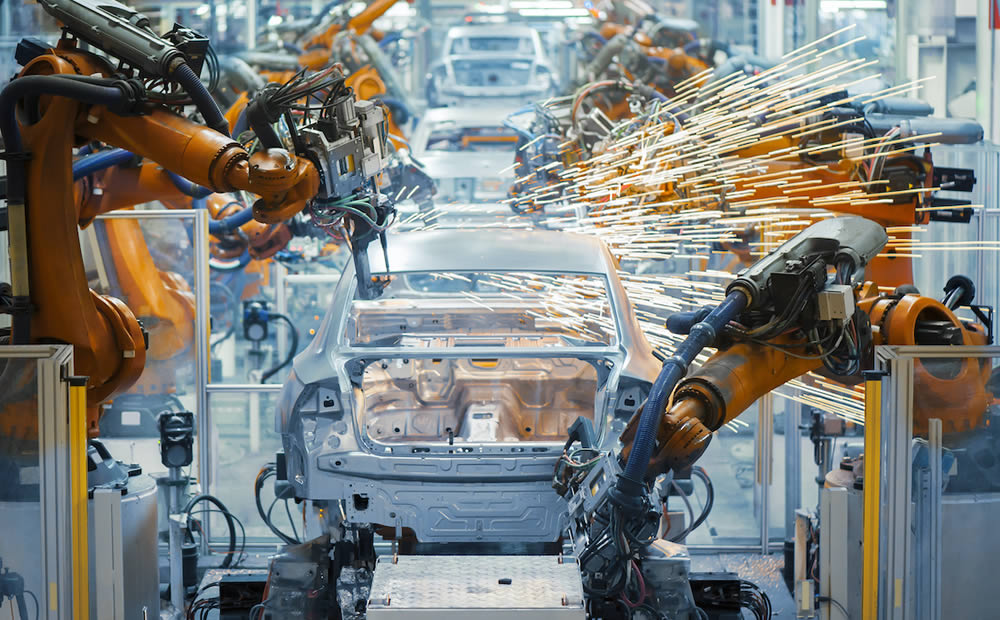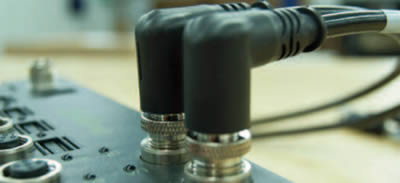IoT/IIoT Connections in Unforgiving Environments
Filed under: General, IoT
Comments: Comments Off on IoT/IIoT Connections in Unforgiving Environments


Over the past decade, we’ve heard a lot about the Internet of Things (IoT) and how it will transform our daily lives. While IoT has become a bit of an overused and often misused term, no one can deny the growing number of connected “things” collecting and transmitting data via Internet protocol (IP) over Ethernet-based networks. This is also happening in the industrial environment with the proliferation of industrial Ethernet and more connected industrial devices and machines to support supervisory, control, monitoring and collection of real-time production data. As a result, we now also hear quite a bit about Industrial IoT (IIoT) and how it will transform the manufacturing industry.
While IoT and IIoT both relate to the concept of devices communicating via IP, and they share some common connector interfaces and intelligence, they are in fact quite different in terms of their primary use and goal. IoT refers primarily to commercial applications used by consumers and end users with a focus on everyday systems that support business needs, communication, safety, security, health and wellbeing with the primary goal of improving business outcome and daily life. In contrast, IIoT refers primarily to industrial applications used by machines and production equipment with a focus on automated control and monitoring to improve efficiency, maximize productivity and optimize operations.
There are other key differences between IoT and IIoT networks including Ethernet application requirements (i.e., collision detection vs. deterministic real-time Ethernet) and topology variations, but often one of the most talked about differences are the environmental factors to which these networks are exposed. These include potential mechanical forces (e.g., crushing and vibration), ingress of liquids and dust, chemical or climatic issues (e.g., temperature and corrosive solvents), and electromagnetic interference (EMI). While industrial environments and IIoT devices are most often associated with these factors, the proliferation of IoT means that devices communicating via standard commercial Ethernet may also be located in more unforgiving environments than ever before. Whether it’s point-of-sale machines in outdoor eateries, Wi-Fi access points in a science laboratory, security cameras at a marina or medical equipment in an operating room, cables and connectors use to establish connections can also be at risk. That means many of the cable and connectivity characteristics required for IIoT may also be required for IoT.
Thankfully there are industry standards that look at these environmental factors using the MICE (Mechanical, Ingress, Climatic and Electromagnetic) method of classification and consider each of them at various levels of harshness, including Level 1 for everyday commercial office environments, Level 2 for light industrial and Level 3 for industrial. MICE parameters can be instrumental in selecting cables and connectors for both IoT and IIoT connections. Let’s take a look at a few characteristics to meet various MICE parameters.

Sealed for Ingress Protection
Connectors are of important consideration in unforgiving environments because they can be a source of ingress. When dust and liquids infiltrate network connections, contacts within jacks and plugs can become corroded and no longer maintain connectivity. For example, consider an operating room in a hospital where mobile heart monitors, respirators and other machinery are wheeled in. Solvents used to disinfect the environment can infiltrate unprotected equipment connections and over time potentially cause those connections to malfunction, which could be catastrophic in that environment.
Ingress doesn’t just apply to liquids. The “I” in standards-based MICE parameters also looks at particulate matter (i.e., dust and debris) and classifies the level of protection based on the maximum diameter of a particulate. For example, a Level 1 commercial environment allows for a maximum particulate diameter of 12.5 millimeters while Level 2 and Level 3 environments allow a maximum of 50 micrometers. One standards-based rating to consider for unforgiving environments is ingress protection (IP) ratings developed by the European Committee for Electro Technical Standardization (CENELEC). Sometimes referred to as an IP code, the IP rating consists of the letters “IP” followed by two digits-the first digit classifying protection against solids (e.g., dust) and the second classifying protection against liquids (e.g., water). A common IP rating for ruggedized network connectivity is IP67, which offers total protection against dust ingress and water ingress.
It’s not always just the outlet and plug interface to consider when it comes to ingress protection. IP44-rated stainless steel faceplates with rear sealing gaskets provide a protective seal that prevents moisture and debris from infiltrating the space behind the wall where outlets are terminated to the cable. Note that connections that reside within enclosures may not require additional projection and an IP67 rating, but the enclosure itself may need to offer protection. The National Electrical Manufacturers Association (NEMA) uses a standard rating system for enclosures that includes IP code equivalents. For example, a NEMA 4X enclosure offers the equivalent of an IP66 rating.
| Protection Against Solids | ||
| 0 | No special protection | |
| 1 | >50 mm | Protected against objects greater than 50 mm (e.g., accidental touch by surface of human hands) |
| 2 | >12.5 mm | Protected against solid objects greater than 12 mm (i.e., human finger size) |
| 3 | >2.5 mm | Protected against solid objects greater than 2.5 mm (e.g., tools, thick wires) |
| 4 | >1 mm | Protected against solid objects greater than 1 mm (e.g., most wires, screws, paperclips) |
| 5 | Dust Protected | Protected against limited dust ingress (e.g., protection against contact but no harmful deposit of dust) |
| 6 | Dust Tight | Totally protected against dust |
| Protection Against Liquids | ||
| 0 | No special protection | |
| 1 | Dripping water | Vertically falling drops have no harmful effect |
| 2 | Dripping water with 15-degree tilt | Vertically falling drops have no harmful effect if enclosure tilted up 15 degrees |
| 3 | Spraying water | Water falling as spray at any angle up to 60 degrees from the vertical has no harmful effect |
| 4 | Splashing water | Water splashing from any direction has no harmful effect |
| 5 | Water jetting | Water projected (12.5 mm nozzle) from any direction has no harmful effect |
| 6 | Immersion up to 1 m | Immersion in water under defined conditions of pressure and time (up to 1 m) has no harmful effect |
| 7 | Immersion above 1 m | Continuous immersion as specified by manufacturer has no harmful effect. Typically hermetically sealed. |
The Vibration Factor
IoT/IIoT connections that are subjected to consistent vibration and movement such as those on machinery or in proximity to drive belts, motors, pumps, fans and other equipment, can experience problems due to misalignment, disconnects and long-term wear caused by loosening. One way to help prevent the impact of vibration is to use bayonet-style mating connectors like Siemon’s Ruggedized copper and fiber connectors. Ruggedized cables that feature an over-molded 90-degree angle can also help maintain vibration for connections versus manual bending of straight connectors that can increase the potential for connectors to come loose.

For even more protection against vibration, some devices will also often make use of M series connectors such as D-coded M12 connectors us in 100 Mbps Ethernet applications. These connectors feature a highly durable impact-resistant circular design that utilizes a locking thread to prevents them from loosening and becoming disconnected or misaligned. They are also IP67 rated for protection against ingress and shielded for protection against EMI. The overall smaller size of the M12 is also ideal for supporting the trend toward smaller IIoT devices and sensors in more places. Siemon offers M12 cable assemblies for these applications.
Cable Construction and Jacket Materials Matter
When it comes to protecting cables in unforgiving environments, the overall construction of the cable and its jacketing materials may need to be considered. For example, environments subjected to EMI from other equipment (e.g., fluorescent lights, air conditioners, X-ray machines, motors, actuators, etc.) should use shielded cabling. EMI can produce disturbing signals that can degrade transmission performance, and the cable shield protects data from those signals. This can be especially critical in an environment like a hospital where proper transmission of data could impact the reliability of life-saving applications. Note that optical fiber cable used to support above 10 gigabit per second transmission speeds, extended distance requirements and backbone cabling is inherently immune to EMI.
Other characteristics to look for in cables might be increased operating temperature durable jacketing and the use of more jacket materials that are resistant to the various environmental elements present in production and other harsh environments. While polyvinyl chloride (PVC) jacketing used for commercial-grade cables can support some light industrial environments, other environments might need a little something more. For example, thermoplastic elastomer (TPE) jacket materials support wider operating temperature ranges and are more resistant to sunlight, moisture, abrasion and corrosive chemicals, while polyurethane (PUR) is bit more mechanically tough with a higher tensile strength and tear resistance for use on machinery. That’s why Siemon Ruggedized Category 6A shielded cable assemblies are available with a TPE jacket and our M12 cable assembles feature a PUR jacket.
